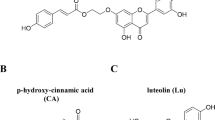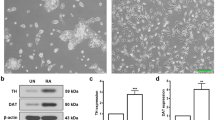Abstract
Alzheimer’s disease (AD) is a progressive neurodegenerative disorder. Many molecular lesions have been detected in AD, of which the most commonly observed is the accumulation of misfolded proteins, including β-amyloid (Aβ40 and Aβ42) and tau, in the aging brain. The mammalian target of rapamycin (mTOR) pathway mediates Aβ clearance through autophagy and regulates tau phosphorylation via glycogen synthase kinase-3β (GSK3β). Thus, mTOR becomes an important therapeutic target for AD. However, no mTOR inhibitor has yet been marketed to treat AD. Here, we discovered a natural product, wogonin, which could potently promote Aβ clearance in the primary neural astrocytes and significantly decrease Aβ secretion in SH-SY5Y-APP and BACE1 cells [SH-SY5Y cells stably expressing the human amyloid precursor protein (APP) and β-secretase (BACE1)] through the mTOR/autophagy signaling pathway. Additionally, further research revealed that wogonin inhibited the activity of GSK3β via mTOR inhibition, finally leading to tau phosphorylation reduction in SH-SHY5Y cells and primary neural astrocytes. In conclusion, our study identified a small molecule, wogonin, which could effectively promote Aβ clearance and decrease tau phosphorylation, and highlighted its therapeutic potential for AD treatment.




Similar content being viewed by others
References
Grundke-Iqbal I, Iqbal K, Tung YC et al (1986) Abnormal phosphorylation of the microtubule associated protein tau (tau) in Alzheimer cytoskeletal pathology. Proc Natl Acad Sci USA 83:4913–4917
Kirschner DA, Abraham C, Selkoe DJ (1986) X-ray diffraction from intraneuronal paired helical filaments and extraneuronal amyloid fibers in Alzheimer disease indicates cross-beta conformation. Proc Natl Acad Sci USA 83(2):503–507 (PMID: 3455785)
Hardy J, Selkoe DJ (2002) The amyloid hypothesis of Alzheimer’s disease: progress and problems on the road to therapeutics. Science 297:353–356
Younkin SG (1998) The role of A beta 42 in Alzheimer’s disease [J]. J Physiol Paris 92(3–4):289–292
Vingtdeux V, Chandakkar P, Zhao H et al (2011) Novel synthetic small-molecule activators of AMPK as enhancers of autophagy and amyloid-beta peptide degradation. FASEB J 25:219–231 (PMID: 20852062)
Zhu Z, Yan J, Jiang W et al (2013) Arctigenin effectively ameliorates memory impairment in Alzheimer’s disease model mice targeting both beta-amyloid production and clearance. J Neurosci 33:13138–13149
Tang Z, Bereczki E, Zhang H, Wang S, Li C, Ji X, Branca RM, Lehtiö J, Guan Z, Filipcik P, Xu S, Winblad B, Pei JJ (2013) Mammalian target of rapamycin (mTor) mediates tau protein dyshomeostasis: implication for Alzheimer disease. J Biol Chem 288:15556–15570
Caccamo A, Magri A, Medina DX et al (2013) mTOR regulates tau phosphorylation and degradation: implications for Alzheimer’s disease and other tauopathies. Aging Cell 12:370–380
Yue GG, Chan BC, Kwok HF et al (2012) Screening for anti-inflammatory and bronchorelaxant activities of 12 commonly used Chinese herbal medicines. Phytother Res 26:915–925
Li BQ, Fu T, Yan YD et al (1993) Inhibition of HIV infection by baicalin–a flavonoid compound purified from Chinese herbal medicine. Cell Mol Biol Res 39:119–124
Bubeck Wardenburg J, Patel RJ, Schneewind O (2007) Surface proteins and exotoxins are required for the pathogenesis of Staphylococcus aureus pneumonia. Infect Immun 75:1040–1044 (PMID: 17101657)
Zhao K, Song X, Huang Y, Yao J, Zhou M, Li Z, You Q, Guo Q, Lu N (2014) Wogonin inhibits LPS-induced tumor angiogenesis via suppressing PI3K/Akt/NF-κB signaling. Eur J Pharmacol 737:57–69
Chen XM, Bai Y, Zhong YJ, Xie XL, Long HW, Yang YY, Wu SG, Jia Q, Wang XH (2013) Wogonin has multiple anti-cancer effects by regulating c-Myc/SKP2/Fbw7α and HDAC1/HDAC2 pathways and inducing apoptosis in human lung adenocarcinoma cell line A549. PLoS One 8(11):e79201
Lin B (2011) Polyphenols and neuroprotection against ischemia and neurodegeneration. Mini Rev Med Chem 11(14):1222–1238
Landreth GE, Cramer PE, Lakner MM et al (2013) Response to comments on “ApoE-directed therapeutics rapidly clear beta-amyloid and reverse deficits in AD mouse models”. Science 340:924-g (PMID: 23704556)
Klionsky DJ, Abdalla FC (2012) Guidelines for the use and interpretation of assays for monitoring autophagy. Autophagy 8(4):445–544
Kim J, Kundu M, Viollet B, Guan KL (2011) AMPK and mTOR regulate autophagy through direct phosphorylation of Ulk1. Nat Cell Biol 13:132–141
Song HR, Cheng JJ, Miao H et al (2009) Scutellaria flavonoid supplementation reverses ageing-related cognitive impairment and neuronal changes in aged rats. Brain Inj 23:146–153
Jeong K, Shin YC, Park S et al (2011) Ethanol extract of Scutellaria baicalensis Georgi prevents oxidative damage and neuroinflammation and memorial impairments in artificial senescense mice. J Biomed Sci 18:14
Shang YZ, Gong MY, Zhou XX et al (2001) Improving effects of SSF on memory deficits and pathological changes of neural and immunological systems in senescent mice. Acta Pharmacol Sin 22:1078–1083
Kim DH, Kim S, Jeon SJ et al (2008) The effects of acute and repeated oroxylin A treatments on Abeta(25–35)-induced memory impairment in mice. Neuropharmacology 55:639–647
Hwang YK, Jinhua M, Choi BR et al (2011) Effects of Scutellaria baicalensis on chronic cerebral hypoperfusion-induced memory impairments and chronic lipopolysaccharide infusion-induced memory impairments. J Ethnopharmacol 137:681–689
Guertin DA, Sabatini DM (2005) An expanding role for mTOR in cancer. Trends Mol Med 11:353–361 (Pubmed:16002336)
Li X, Alafuzoff I, Soininen H et al (2005) Levels of mTOR and its downstream targets 4EBP1, eEF2, and eEF2 kinase in relationships with tau in Alzheimer’s disease brain. FEBS J 272:4211–4220
Abel T, Lattal KM (2001) Molecular mechanisms of memory acquisition, consolidation and retrieval. Curr Opin Neurobiol 11:180–187
Caccamo A, Majumder S, Richardson A et al (2010) Molecular interplay between mammalian target of rapamycin (mTOR), amyloid-beta, and Tau: effects on cognitive impairments. J Biol Chem 285:13107–13120
Spilman P, Podlutskaya N, Hart MJ et al (2010) Inhibition of mTOR by rapamycin abolishes cognitive deficits and reduces amyloid beta levels in a mouse model of Alzheimer’s disease. PLoS One 5:e9979
Yu C, Wang L, Lv B et al (2008) TMEM74, a lysosome and autophagosome protein, regulates autophagy. Biochem Biophys Res Commun 369:622–629
Tang Z, Bereczki E, Zhang H et al (2013) Mammalian target of rapamycin (mTor) mediates tau protein dyshomeostasis: implication for Alzheimer disease. J Biol Chem 288:15556–15570
Talbi A, Zhao D, Liu Q, Li J, Fan A, Yang W, Han X, Chen X (2014) Pharmacokinetics, tissue distribution, excretion and plasma protein binding studies of wogonin in rats. Molecules 19(5):5538–5549
Bloom GS (2014) Amyloid-β and tau: the trigger and bullet in Alzheimer disease pathogenesis. JAMA Neurol 71(4):505–508
Rapoport M, Dawson HN, Binder LI, Vitek MP, Ferreira A (2002) Tau is essential to β-amyloid-induced neurotoxicity. Proc Natl Acad Sci USA 99(9):6364–6369 (PMID:11959919)
King ME, Kan HM, Baas PW, Erisir A, Glabe CG, Bloom GS (2006) Tau-dependent microtubule disassembly initiated by prefibrillar β-amyloid. J Cell Biol 175(4):541–546 (PMID:17101697)
Conflict of interest
The authors report no conflicts of interest.
Author information
Authors and Affiliations
Corresponding author
Rights and permissions
About this article
Cite this article
Zhu, Y., Wang, J. Wogonin increases β-amyloid clearance and inhibits tau phosphorylation via inhibition of mammalian target of rapamycin: potential drug to treat Alzheimer’s disease. Neurol Sci 36, 1181–1188 (2015). https://doi.org/10.1007/s10072-015-2070-z
Received:
Accepted:
Published:
Issue Date:
DOI: https://doi.org/10.1007/s10072-015-2070-z




